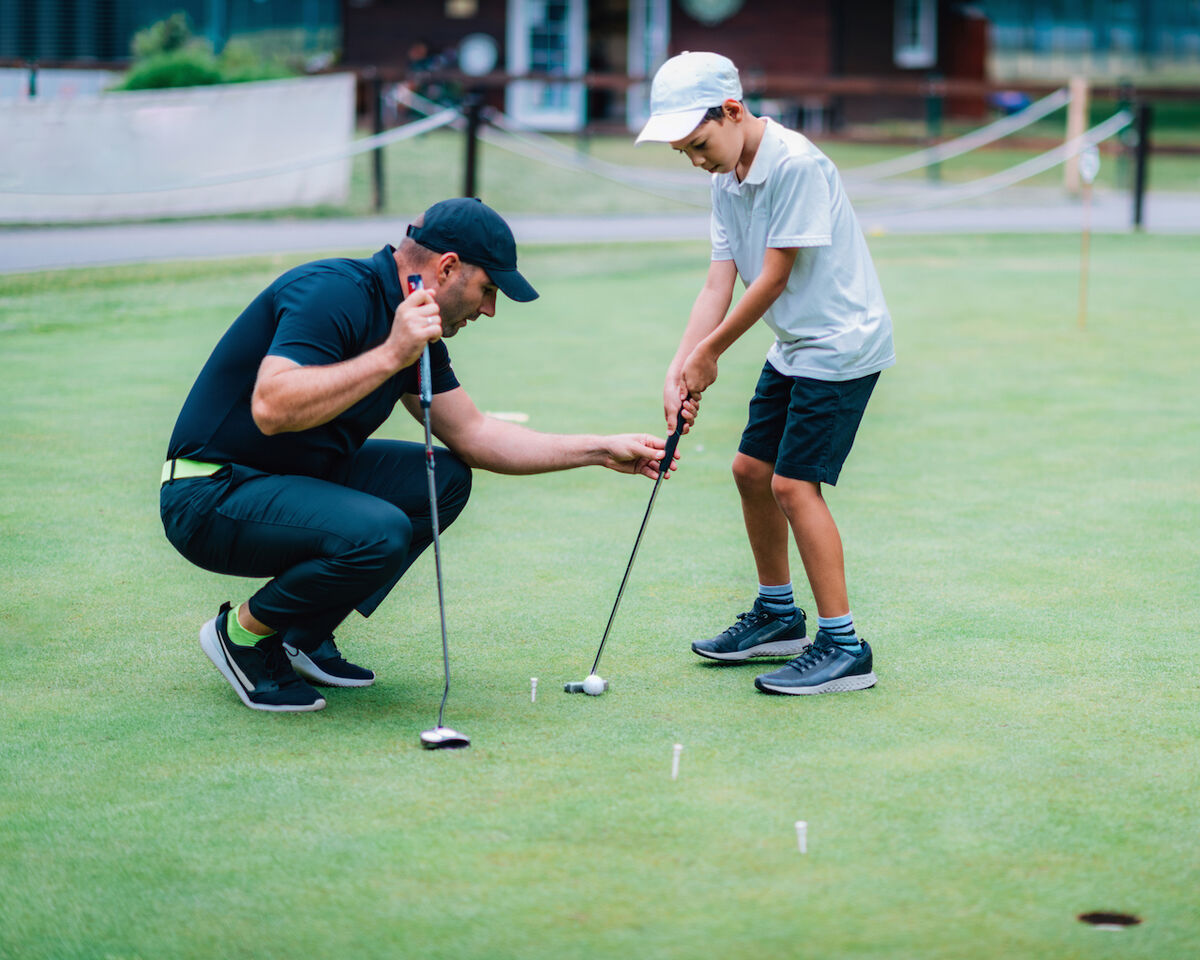Golf For Beginners: 10 Tips For Newbie Golfers
If you're new to the game, these 10 golf basics will help you learn and enjoy the game much quicker!

I have been involved in golf for over four decades, first as a player, then as an industry professional for 28 years, and as a PGA Professional for 15 years. As a PGA Professional, it’s my job to introduce people to golf, grow their love for it, and guide them on their golf journey. It’s normal for new golfers to feel inadequate, apprehensive, and nervous. These are natural feelings when starting something new.
Golf is a complex game that involves many principles, equipment, and rules. Golfers must master basic things such as posture, grip, and alignment; and advanced concepts like the ball flight laws. It can be daunting, but also very rewarding.
To pile on, golf has a complex set of rules plus unofficial do's and don'ts that most golfers pick up along the way.
When you add all that up, it’s no surprise that learning golf as a beginner can be overwhelming. As a professional who has been helping people enjoy and get better at golf for 28 years, I would like to share 10 valuable tips for beginner golfers. These tips are based on my own experience, and they will be helpful for anyone starting their golf journey.
1. Get Started Right Through Professional Instruction

Golf is as popular as it’s ever been, and it's great to see so many new people taking up the sport. However, many new golfers overlook one of the most important things they could do as a beginner: get lessons.
Statistics show that less than 20% of golfers take professional lessons. Since golf is a complex game, getting a proper start is crucial for long-term enjoyment.
Some people think professional instruction and coaching is expensive, but that's not necessarily true. Beginners can opt for group instruction as they start. Group lessons are a cost-effective way to learn the basics and gain a strong foundation of the golf swing. Group lessons often cost only $25 or less per session. To find PGA of America-certified instructors and program offerings in your area, check out www.pga.com/coach.
2. Find a Golf Buddy or Regular Group
This advice is often overlooked but extremely valuable. It's important to find a friend or two to learn, practice, and play golf with. One great way to connect with others who share the game is through group lessons, which I mentioned above. Group clinics are a fantastic way to meet others who are also starting their journey in the game.
This is also great advice for intermediate players. I encourage all of my teenage competitive players to exchange numbers, practice and play together. This has always been a significant building block in their development.
3. Start With P.G.A: Posture First
P.G.A. is an acronym that stands for Posture Grip and Alignment. These are the basic fundamentals in golf and are critical to nail early on in your journey.
Posture in golf refers to the way you set up to the ball. To move your body effectively and efficiently as you swing, you need to have a good posture during setup.
Here is how you achieve this:
- Stand up straight, with your shoulders back and feet shoulder-width apart. Feel as though you have a strip of velcro running down your spine and another strip on a wall in line with your spine. Get those two pieces of velcro matched up together.
- Relax your arms, keeping them straight, and then hold the club out in front of you with your hands waist high. Your spine should still be up against the imaginary velcro strip on the wall.
- Start to bend forward slowly. You will start to peel the velcro strip off the wall, starting with the top of your back. Continue to peel the spine off the wall as you bend forward from your hips. It is important to try to keep your back straight as you go until the clubhead gets just above the grass.
- Introduce a very slight knee bend. This will help you get the clubhead soled on the ground and behind the ball.
Setting up in your posture consistently, each and every time, helps you become a more consistent ball-striker.
4. Learn the Proper Golf Grip
The second step in the P.G.A. acronym is Grip. The only connection you have between your body and the club is your hands. That makes how you put your hands on the club rather important.
Like with posture, I could go very deep into explaining what a good grip is, but at the same time, there really are only a few constants you should know.
- Your hands should always work together, never against each other. To check this, make sure the “V’s” on each hand, which is created between your index finger and thumb, run parallel to each other.
- For a neutral grip, those “V’s” should point towards your trail shoulder in your setup.
- As you grip the club, make sure that the clubface is square to your target line. Avoid having the clubface too open or closed at address.
- No matter how you decide to grip it (Interlock, Overlap, or Baseball grip), make sure your hands are connected and together in setup.
- Do not grip the club too hard. Too tight of a grip creates tension that runs up through your forearms, into your shoulders, and down through your chest. That tension restricts your ability to swing freely.
5. Alignment
The last step in the P.G.A. acronym is Alignment. This may be one of the most important fundamentals in golf and one that many golfers get wrong, regardless of ability level. I fight poor alignment myself, and all of my students do as well from time to time.
The two most important things to remember in alignment include the following:
- The Target Line is an imaginary straight line that runs from behind your golf ball to where you want your golf ball to go once struck initially.
- Your Body Lines, inclusive of your toes, knees, hips, and shoulders, should run parallel left (for right-handed golfers) to your Target Line.
- Clubface Alignment, the majority of the time, should see the center of your clubface pointing toward the target. Your target is where you want the ball to end up if hit properly.
A common mistake among new or high-handicap golfers is to align their bodies to the target, rather than parallel to it. The correct alignment is to have the clubface in line with the target.
The Target Line is the direction in which the clubface moves during the swing, while the Body Lines should be parallel to the left of your Target Line (parallel to the right for left-handed golfers).
6. Learn Swing Positions
To improve your golf swing, it's helpful to understand how your body and the club should move during the swing. You need to know how the club moves back to the top of the swing, comes down to hit the ball, and moves on to a balanced finish, all while moving in a slight arc.
There are various methods to keep everything in line, but one worth considering is the approach of Mac O'Grady, a respected coach and golf expert. O'Grady has divided the swing into ten positions, which is a useful way to break down the technique.
- P1: Address.
- P2: Club Shaft Parallel With Ground On Takeaway.
- P3: Lead Arm Parallel With Ground.
- P4: Top of Backswing.
- P5: Lead Arm Parallel With Ground on Downswing.
- P6: Club Shaft Parallel With Ground on Downswing.
- P7: Impact.
- P8: Club Shaft Parallel With Ground on Follow-Through.
- P9: Trail Arm Parallel With Ground on Follow-Through.
- P10: Finish
I recommend any beginning golfer use this as a starting point. It makes learning the swing easier, and I believe it will accelerate your understanding of the golf swing.
7. Take Pride In Your Short Game & Putting
Did you know that in a round of golf, about 60% of all your shots are from 100 yards and in? That’s why it’s crucial to develop a strong wedge game, pitching and chipping technique, and a solid putting stroke.
To improve your short game, I recommend a two-step approach.
First, you must practice the proper technique to be a good wedge and greenside golfer. You also need to understand the foundations of being a great putter, which can be achieved through instruction followed by specific technical practice.
During technical practice, your goal is to work on and perfect a proper repetitive motion for striking putts, hitting chips and pitches, and controlling wedge shots.
The second phase of getting your short game and putting sharp is gamification. This concept requires less focus on technique and more on gaining instinct around the green and strategizing. Playing chipping and putting games with friends, such as an 18-hole match on the practice green, can be incredibly beneficial.
8. Play Golf Not Golf Swing
Learning how to play golf and score well is an entirely different skill set from learning the swing, short game, and putting. Golfers who focus too much on technique while playing on the course often find it difficult to actually play the game.
This mindset hinders their ability to play golf effectively. To play well, golf requires a combination of instinct, assessment, and strategy. Focusing solely on the mechanics of the swing, which I refer to as "playing golf swing," limits the golfer's ability to focus on the ultimate goal of getting the ball into the hole.
9. Become a True Golfer!
If you want to become a successful golfer, you must develop a passion for the game. Immerse yourself in golf lifestyle and culture to gain a genuine appreciation for the sport.
Watch golf on TV or online, attend tournaments, and follow popular golf YouTubers. Not only will this help you enjoy golf more, but I promise it will also improve your skills.
10. Enjoy the Journey & Trust the Process
Golfers are known for being very self-critical and frequently undermine their potential through a bad attitude.
Following a subpar round or practice session, golfers tend to question themselves, "Why am I not improving my game?" In most cases, they already know the answers to that question but either choose to ignore the truth or are hesitant or incapable of taking the necessary steps to enhance their skills.
As a coach of teenage competitive golfers, I always deal with the emotional aspect of the game. Despite having good skills, young players often struggle with managing their emotions and expectations. Therefore, we work on this aspect frequently, sometimes as a central theme of our training sessions. I must constantly remind them to enjoy the journey and trust the process.
It's not just teenagers who face this challenge. Regardless of age or ability level, everyone who plays golf can face difficulties keeping their emotions in check while playing or practicing.
However, with proper training and practice, anyone can improve their game and have fun on the course. Avoiding common pitfalls and enjoying the experience is vital to playing good golf.